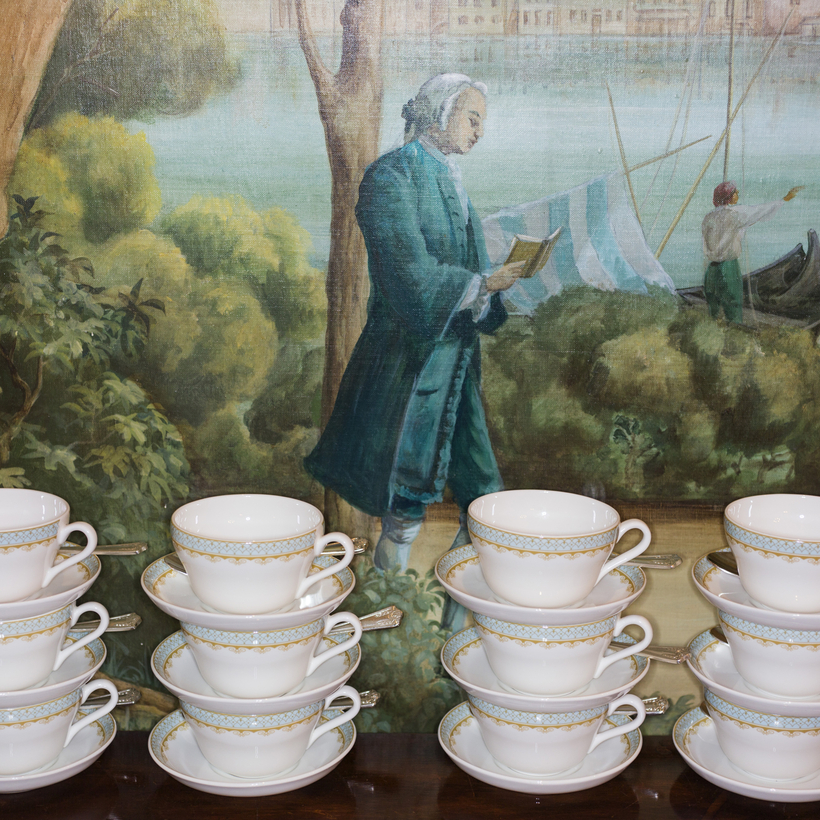With sweet symmetry, the next Great British Lockdown coincides with the publication of Scoff: A History of Food and Class in Britain—and, in theory, just when we all have more time to read, cook, eat, and repeat.
Two mild observations about lockdowns, if I may. I worry they are enforced periods during which rich people have poor people deliver them goods and services, and the government shutters this nation of shopkeepers by closing “non-essential” retail—and therefore robs both Peter and Paul to pay Jeff Bezos.
We all know that books as well as food are essential. (Erasmus said he spent what little money he had on books and any he had left on food and clothing.) Scoff is an essential book about food. It unpacks the hamper of British food—not so much our spongy, milky puddings, our nursery food, our gut-busting breakfasts, but the meaning of what we eat. What does it reveal about us? Is our nosh posh or not? What is the smartest thing an Englishwoman can eat? (Answer at the end of this article.)
Astonishing to think that nobody has done this book before. Professor Henry Higgins boasted he could place any man within six miles from his accent. Yet we judge each other just as much on what we put in our mouths as on what comes out of them.
What does it reveal about us ? Is our nosh posh or not?
The thesis of Scoff is therefore sound as a pound, which is, according to the author, Pen Vogler, that we put more time and energy into classifying and rating people on what we eat, and the way we eat it, than on the food itself.
Indeed. If you want to get Brits really exercised, ask them whether it’s correct to put the milk in first or last and stand back. (I’m talking about tea.) Speaking of M.I.F. (Milk in First) snobbery, it’s impossible not to watch the addictive new season of The Crown through the same nit-picking goggles. Top royal experts have been wheeled out to scour every frame for unforgivable solecisms, especially when it comes to the fields of hunting, shooting, fishing, the etiquette and attire of country-house weekends, and the armed forces.
Here’s just one example: “The Queen is in the uniform of Colonel-in-Chief of Grenadier Guards with the riband of the Garter, whereas it was the colour of the Scots Guards being trooped that year, and on that day she wore the uniform of Colonel-in-Chief of Scots Guards (a thistle, not a grenade on the collar) and the dark green riband and star of the Order of the Thistle – and no plume in her cap as it is the central of the five regiments of guards. Prince Philip should also have worn a green Thistle riband – not a blue Garter one, as he did in June 1979,” huffs Hugo Vickers in The Times.
I can’t go through it all, so I’ll restrain myself to this comment.
Those who regard themselves as genuine aristocrats with bloodlines reaching back deep into the Middle Ages look down at the royal family as hearty Germanic arrivistes. If you doubt me, read again Charles (Earl) Spencer’s spine-chilling oration for his sister at her funeral when he dwelt memorably on the precedence of his nephews’ “blood family” over the royals.
To the truly posh, the royals are—as the neat phrase glossed in Pen Vogler’s Scoff would put it—below the salt. The Queen even made a rueful joke about this once.
Princess Michael, although born a commoner, is on record as saying that she had more royal blood than anyone who has married into the royal family since Prince Philip married the Queen, in 1947.
Lord Mountbatten passed this on to the Queen. “Well, Dickie,” Her Majesty is said to have replied, “she sounds far too grand for us!”

In this country, food does not unite us—it divides us, into upper, middle (which divides into upper-middle, lower-upper-middle, middle-middle, and lower-middle), and lower or working class.
A small war broke out in the southwest after I tweeted a picture of my home-baked scones with the clotted cream loaded first, raspberry jam on top. I should explain that in Devon cream comes first, but in Cornwall, the home of the most golden, crustiest baked clotted cream, it’s the other way round, as it is in the royal palaces, where the Queen insists homemade Balmoral jam comes first.
I once spent a happy hour on the Queen Mary indoctrinating P. J. O’ Rourke into the mysteries of English meals as we laid about a three-course tea of sandwiches, scones, and dainty cakes, all proffered on silver salvers by white-gloved waiters between bottomless refills of leaf tea.
After breakfast came lunch, called “dinner” if you were working class and from the North, I explained. The evening meal was supper/dinner, taken around eight p.m. if you were middle class, or “tea” at six p.m. if you were working class and Northern. There are many more meals than that: elevenses, “high tea” (a farmhouse meal taken in the kitchen around five p.m. after a day of horny-handed toil), and weddings and formal balls have lavish “breakfasts” at any time of day or night.
To the truly posh, the royals are—as the neat phrase glossed in Pen Vogler’s Scoff would put it—below the salt.
No conversation about food, as to whether it is U or non-U, is complete without the pitiless verdict of Nicky Haslam, the ultimate authority as to what is hot and what is not. He even sells tea towels printed with lists of things he thinks are common, from signet rings to sorbets.
When I spoke to Nicky, there was a noisy debate on Twitter as to whether baked beans had a place in the full English breakfast. “Are baked beans common?,” I therefore asked Haslam first.
“Baked beans are delicious on toast, but they look so horrible with fried eggs, like those photographs of meals on plastic menus in cheap restaurants. I’ll tell you what is common, though,” he said. Then he paused. I expected he would say something like “vegetables.” But no.
“Truffles, anything truffle-flavored—and fish,” pronounced Nicky Haslam, before telling me that when he was a boy his nanny would ask if he wanted a “wet dinner” or a “dry dinner,” by which she meant with or without gravy. He also revealed that the only fish he liked were goujons of sole, served at midnight, after a ball, as they reminded him of fish sticks.

Baked beans, fish sticks … it’s not what you eat; it’s the way that you eat it. Some top firms insist on seeing a prospective employee at table, to check he’s not H.K.L.P. (Holds Knife Like Pen), or eats his asparagus with a fork. You can’t go to bed with someone you haven’t broken bread with.
I once went to a dinner where the host had already plated up our actual main courses at each place. He had also covered the filled salad bowl with cling film, a sight from which I have never quite recovered. “Very lower-middle,” a fellow female guest whispered in my ear.
You may say this is mere English snobbery, but Americans judge each other by food choices, too. The New York Times recently published photographs of the insides of fridges and invited readers to guess whether the fridges belonged to Biden or Trump voters. If a fridge had Meatloaf Meal, frankfurters, rank takeaway cartons, and so on, everyone said it was a Trump voter’s, while a fridge with coconut water or any fruit and veg in the crisper compartment was automatically assumed to be a Democrat’s.
Don’t scoff. Food, and meals, are signifiers of both sides of the pond, but it’s all about context. Time and place. Going out for a hamburger can be a lot more fun than having a steak at home.
Oh, yes, the smartest meal of all in England? The most U as opposed to non-U? As fans of Miss Mitford could tell you, it’s eggs for tea by the fire after a wet day’s hunting.
Rachel Johnson is a journalist and the author of Rake’s Progress: My Political Midlife Crisis. Her brother Boris is prime minister of Britain


